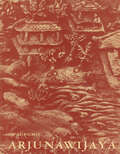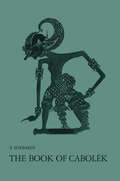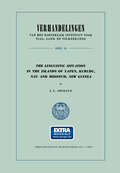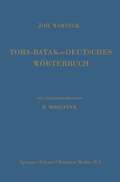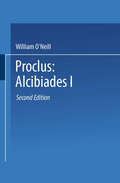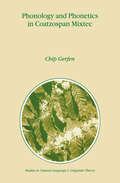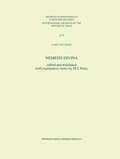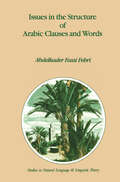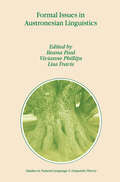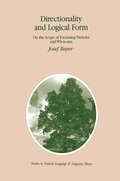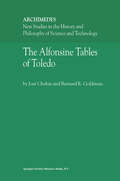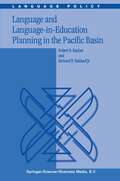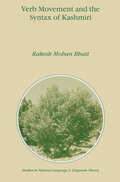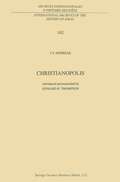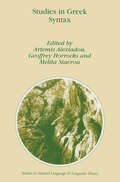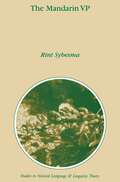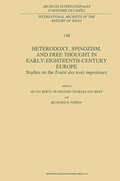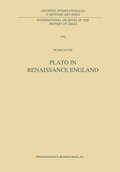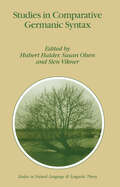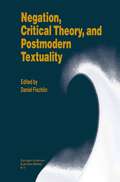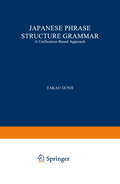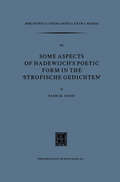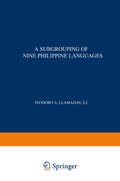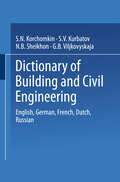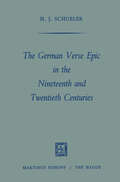- Table View
- List View
The Book of Cabolèk: A Critical Edition with Introduction, Translation and Notes. A Contribution to the study of the Javanese Mystical Tradition (Bibliotheca Indonesica #10)
by I. YasadipuraThe Scope of the Work The main purpose of this work is to give a critical edition of a Javanese text - the Serat Cabolek - together with an Introduction, an English trans lation of the text, and Notes. The present publication is a slighdy revised version of a doctoral dissertation submitted to the Australian National Univer sity in 1967. The Introduction to the text begins with a brief description of each of the extant MSS of the Serat Cabolek to be found in the Manuscript Sections of the Jakarta Museum Library and the Lembaga Kebudayaan Indonesia and in the Griental Manuscripts Section of the Leiden University Library. In addition, a description is given of a printed version of the Serat Cabolek. The eleven MSS and the printed text are compared with one another on the points of form, structure and content, in order to discover their mutual relationship. From this comparison it becomes clear that no matter how much these eleven MSS and the printed text of theSerat Cabolek may differ the one from the other, they all share a common core and all ultimately derive from a single source. The kernel of the Serat Cabolek in all probability comprised only the following sections: (1) the story dealing with the trial of Haji Mutamakin by the Kartasura tribunal; (2) the teaching of Dewa Ruci to Bhima; and (3) a commentary on Dewa Ruds counsel to Bhima.
The Linguistic Situation in the Islands of Yapen, Kurudu, Nau and Miosnum, New Guinea (Verhandelingen van het Koninklijk Instituut voor Taal-, Land- en Volkenkunde)
by J. C. Anceaux2. The Sources 3 3. The Language Map . 6 4. The Comparative Word-List. 13 5. The quantitative Analysis . 80 6. Phonological Relationships 149 7. Verbal Forms . 150 8. Elements for indicating personal possession of the parts of the body. . . . . . . . . 157 . 9. Elements to indicate possession with regard to kinship terms . . . . . . . 163 Language Map at the end of the volume. -----------,, ..... --------- ', .......... A ' ~~ \ ~~ ~ \ \ .......... e· ., .. c. \ A-Biak '',, _____________ _ ,, ---~-' B-Waropen ............... ~ ---------- ~--- C-Mor D-Wandamen ~ E-Dusner f. Ron G-Meoswar Geelvink Bay H -lrarutu ...... , .......... ..... , ..... I ' " I I 0 I Sketch Map I I I ,-----; I \ \~_/\ ' of the H 11~£W~ I I \ \. 1,_'8_} n / r ';!?;' r ' • Geelvink Bay Area (Scale 1 : 2.350.000) Indicated are the areas of the languages used for comparison.
Proclus: A Translation and Commentary
by William O’NeillThis translation and commentary is based on the Critical Text and Indices of Proclus: Commentary on the First Alcibiades of Plato, Amsterdam 1954, by L. G. Westerink. Index II has been of great help in the translation, and the commentary is much indebted to the critical apparatus. Dr. Westerink has also been kind enough to forward his views on the relatively few problems which the Greek text has presented. A further debt is owed to the review of Dr. Westerink's text by Prof. E. R. Dodds in GNOMON 1955 p. 164-1, chiefly for some references and some emendations to the Greek text. W. R. M. Lamb's Loeb translation of Alcibiades I has helped considerably in construing the lemmata, which Signor Antonio Carlini has found to have been inserted by a later hand from a Plato MSS. of the W family. Evidence for this is their discrepancy with the text as read in the main body of the commentary (d. Studi Classici e Orientali, vol. x, Pisa 1961). On the personal side, the whole work has received the benefit of constant advice from Prof. A. H. Armstrong. It was he who first suggested the undertaking, and he has been kind enough to read through the translation and commentary, making many corrections and helpful suggestions. In particular lowe him the parallels with Plotinus and thanks for a Socratic patience in my more obtuse moments.
Phonology and Phonetics in Coatzospan Mixtec (Studies in Natural Language and Linguistic Theory #48)
by H. GerfenBACKGROUND This book focuses on two major issues - vowel glottalization and nasalization - in the phonology and phonetics of Coatzospan Mixtec (henceforth CM). CM is an Otomanguean language currently spoken by roughly 2000 people (Small 1990) in the village of San Juan Coatzospan, which is located in the Sierra Mazateca of northern Oaxaca, Mexico.' Though Mixtec constitutes a major branch of the Otomanguean family, the so-called dialects are most appropriately viewed as distinct languages. According to Josserand (1982), there are at least 22 mutually unintelligible varieties of Mixtec. For its part, CM is among the most isolated. Located in the mountains, the village is surrounded entirely by Mazatec speaking communities. Only two other Mixtec languages exhibit over a 25% rate of mutual intelligibility with CM (Josserand 1982). And though it is not clear how this group of Mixtecs came to settle in what is a Mazatec speaking area, their isolation has given rise to special properties not shared by other varieties of the language. Major elements of both the phonology of vowel glottalization and nasalization under focus in this book are, to my knowledge, unique to CM among the Mixtec languages.
Nemesis Divina (International Archives of the History of Ideas Archives internationales d'histoire des idées #177)
by Carl von LinnéLinnaeus' mature theodicy, his attempt to reconcile the suffering and evil of the world with the omnipotence and goodness of God, is presented in a condensed form in the final editions of his Systema Naturae (1758/68). In this comprehensive compendium of our knowledge of the three great realms of organic nature, he outlines the significance of the sub-conscious, social awareness and theological orientation in the spiritual life of man, and indicates how fate, fortune, and Providence interrelate within his conception of the Deity. In the Nemesis Divina this general undertaking is developed into an `experimental theology', which is exactly analogous to Linnaeus' work in the natural sciences, in that it involves the collecting and classifying of concrete and carefully described case-studies. He never prepared the manuscript for publication, however, and for many years it was regarded as lost, and it is only very recently that any attempt has been made to publish it in its entirety. This is the first English translation of all the relevant manuscript material. It is also the first attempt to analyse the case-studies in the light of what we know of Linnaeus' general taxonomic principles, and to relate each of them to its historical context.
Issues in the Structure of Arabic Clauses and Words (Studies in Natural Language and Linguistic Theory #29)
by A. Fassi FehriThis study has a twofold goal. First, it investigates the internal structure of words and clauses in Standard Arabic (SA), in the light of recent developments of Government and Binding Theory (GB). Second, it argues for a specific theory of typology, and proposes a particular view of how parametrization can be construed and executed. SA is a language used throughout the Arab world, in contrast to specific local dialects which are limited to a particular area. The language has a number of features which make it particularly suitable for cross-linguistic comparative morpho-syntax, as well as research in different modules of the theory of grammar. SA morphology is essentially non-concatenative, though a rich analytic affixation system makes word formation hierarchical. Word order in SA is basically VSO, but the language has alternative SVO structures as well. Sentences can be 'nominal' (i.e. with no verb or copula realized at surface structure), or verbal. Arguments can be left syntacti cally unexpressed (i.e. SA is a null argument language). SA is an agreement language, with a rich and complex agreement system interacting with word order, pronominal incorporation, and expletive structures. It also has a productive morphological case system. Tense, Aspect, Modal, and Negation properties interact in intriguing ways. Finally, SA's DP system exhibits interesting complementary distributions between overt determiners, genitive complements, and possessive markers. It also uses different licensing strategies for Genitive Case marking.
Formal Issues in Austronesian Linguistics (Studies in Natural Language and Linguistic Theory #49)
by I. Paul V. Phillips Lisa TravisAustronesian languages have long raised interesting questions for generative theories of syntax and morphology. The papers in this volume encompass some of these traditional questions and place them in newer theoretical contexts. Some of the papers also address new issues which add to our understanding of members of this language family on one side and the nature of linguistic theories on the other. There are three broad issues that re-occur throughout the volume - the role and analysis of verbal morphology, the nature of the subject or the topic in these languages, and the interaction of syntax and specificity. The papers in this volume show that as formal theories become more precise, a wider range of language data can be captured, and as the inventory of language data grows, the accuracy of formal linguistic theories improves.
Directionality and Logical Form: On the Scope of Focusing Particles and Wh-in-situ (Studies in Natural Language and Linguistic Theory #34)
by Josef BayerDirectionality and Logical Form provides a detailed treatment of the syntax of focusing particles, such as only and even in a cross-linguistic perspective. The derivation of logical forms is shown to be under the control, not only of the ECP and subjacency, but also of directionality of government and the particular word-order parameter that holds in a given language: head-final languages systematically disallow certain derivations or readings that are available in head-initial languages. The reason is that heads that deviate in their selection properties from canonical head-finality project a directionality barrier. Various strategies are explored by which this barrier can be circumvented. Although the theory is developed mainly on the basis of the head position in German, it can be directly used to explain constraints on the scope of Wh-in-situ in Bengali and closely related languages. Audience: Syntacticians and semanticists interested in parametric variation, as well as linguists working on Germanic and/or Indo-Aryan languages.
The Alfonsine Tables of Toledo (Archimedes #8)
by José Chabás B.R. GoldsteinThe Alfonsine Tables of Toledo is for historians working in the fields of astronomy, science, the Middle Ages, Spanish and other Romance languages. It is also of interest to scholars interested in the history of Castile, in Castilian-French relations in the Middle Ages and in the history of patronage. It explores the Castilian canons of the Alfonsine Tables and offers a study of their context, language, astronomical content, and diffusion. The Alfonsine Tables of Toledo is unique in that it: includes an edition of a crucial text in history of science; provides an explanation of astronomy as it was practiced in the Middle Ages; presents abundant material on early scientific language in Castilian; presents new material on the diffusion of Alfonsine astronomy in Europe; describes the role of royal patronage of science in a medieval context.
Language and Language-in-Education Planning in the Pacific Basin (Language Policy #2)
by R.B. Kaplan Richard B. Baldauf Jr.This work examines and reviews the ecological context of language planning in 14 countries in the Pacific basin: Japan, the two Koreas, Taiwan, the Philippines, Indonesia, Malaysia, Brunei Darussalam, Singapore, Australia, New Zealand, Papua New Guinea, the Solomon Islands and Vanuatu. It provides the only up-to-date overview and review of language policy in the region and challenges those interested in language policy and planning to think about how such goals might be achieved in the context of language ecology.
Verb Movement and the Syntax of Kashmiri (Studies in Natural Language and Linguistic Theory #46)
by R.M. Bhatt3. 1 Kashmiri is not "non-Configurational" 45 3. 1 . 1 Agreement 51 3 . 1. 2 Binding Theory 52 3. 1. 3 Distribution of PRO 56 3 . 1. 4 Additional Evidence 57 3. 1. 4. 1 Weak Crossover (WCO) 57 3. 1. 4. 2 Constituent Fronting 60 3. 1. 4. 3 Superiority-Like Effects 62 3. 2 Word Order Constraints: Kashmiri Phrase Structure 64 3. 2. 1 N-complements 65 3. 2. 2 Postpositions 67 3. 2. 3 Adjectives 67 3. 2. 4 The Structure ofVP 68 3. 3. The Functional Projections 71 3. 4 Complement ki clauses 74 3. 5 Summary 79 4 Verb-Second (V2) Phenomena 80 4. 0 Introduction 80 4. 1 Kashmiri Vo rfe ld 84 4. 1. 1 V2 Clauses 85 4. 1. 1. 1 Main Clauses 85 4. 1. 1. 2 ki-Clauses 98 4. 1. 2 V3 Clauses 102 4. 1. 2. 1 Declarative Clauses 102 4. 1. 2. 2 Interrogative Clauses 107 4. 2 Some Exceptional Orders 116 vm 4. 2. 1 VI Order 116 4. 2. 1. 1 Declaratives 116 4. 2. 1. 2 Yes/No Questions 120 V-Final Order 4. 2. 2 121 4. 2. 2. 1 Relative Clauses and Adverbial Clauses 121 4. 2. 2. 2 Nonfinite Clauses 126 4. 3 Summary 129 5 Motivating Verb Movement 131 5. 0 Introduction 131 5. 1 The "Standard" Account 131 5. 2 Yiddish and Icelandic 136 5. 2. 1 Diesing (1990) 138 5. 2. 2 Weerman (1989) 141 5. 2. 3 Vikner (1991) 146 5.
Christianopolis (International Archives of the History of Ideas Archives internationales d'histoire des idées #162)
by Mark H. EbellJohann Valentin Andrere (1586-1654) was a multi-faceted product of late Reformation Germany. A theologian who was firmly committed to the Lutheran confession, he could yet see very c1early the flaws in his church and argue for their reform; without being an ecumenicist in the modern sense, he yet admired many aspects of the society he observed in Calvinist Geneva, and he recognised the outstanding merit of individual Catholic scholars. A linguist and a lover of art and music, he was the friend of scientists and an enthusiastic student of mathematics whö held that science leads both to an appreciation of the wonders of the material world and its rejection in favour of more spiritual concerns. In his satirical writing he could be ironic and flippant, his rhetoric was often laboured and over elaborate, but there is no mistaking the sincerity of his outrage at cruelty, inhumanity and injustice. Andrere was optimistic, in that he believed that the corruption and deceit, the luxm. y and deprivation, the hypocrisy, tyranny and sophistry of the age could be transformed in a second reformation; yet there runs through his life a deep-rooted pessimism or depression which makes his willingness to continue the struggle all the more admirable. As early as 1618, while still a young deacon at the beginning of his career, he defined the four ages of l human life as terror, error, labor and horror.
Studies in Greek Syntax (Studies in Natural Language and Linguistic Theory #43)
by A. Alexiadou G. C. Horrocks Melita StavrouThe Mandarin VP (Studies in Natural Language and Linguistic Theory #44)
by Rint SybesmaThe Mandarin VP deals with a number of constructions in Mandarin Chinese which involve the main verb and the material following it, like the object NPs, resultative phrases, durative expressions and other elements. The basis claim defended in this book is that all elements that follow the main verb in a Mandarin sentence form one single constituent which functions as the complement of the verb. The Mandarin VP offers new and original analyses of such hot issues as resultative constructions, the ba-construction and verb-le. In addition, the conclusions drawn from the research into Mandarin syntax are discussed in more general theoretic terms, which leads to original proposals regarding the internal make-up of accomplishments and the status of Theta Theory. The research reported on in this book was concluded within the bounds of mainstream generative theorizing. The Mandarin VP is of interest to all syntacticians, especially those interested in Chinese.
Heterodoxy, Spinozism, and Free Thought in Early-Eighteenth-Century Europe: Studies on the Traité des Trois Imposteurs (International Archives of the History of Ideas Archives internationales d'histoire des idées #148)
by Silvia Berti Françoise Charles-Daubert R. H. Popkin'the oldest biography of Spinoza', La Vie de Mr. Spinosa, which in the manuscript copies is often followed by L'Esprit de M. Spinosa. Margaret Jacob, in her Radical Enlightenment, contended that the Traite was written by a radical group of Freemasons in The Hague in the early eighteenth century. Silvia Berti has offered evidence it was written by Jan Vroesen. Various discussions in the early eighteenth century consider many possi ble authors from the Renaissance onwards to whom the work might be attributed. The Trois imposteurs has attracted quite a bit of recent attention as one of the most significant irreligious clandestine writings available in the Enlightenment, which is most important for understanding the develop ment of religious scepticism, radical deism, and even atheism in the seventeenth and eighteenth centuries. Scholars for the last couple of decades have been trying to assess when the work was actually written or compiled and by whom. In view of the widespread distribution of manu scripts of the work all over Europe, they have also been seeking to find out who was influenced by the work, and what it represented for its time. Hitherto unknown manuscripts are being turned up in public and private libraries all over Europe and the United States.
Plato in Renaissance England (International Archives of the History of Ideas Archives internationales d'histoire des idées #141)
by S. JayneThis book offers a radical reappraisal of the reputation of Plato in England between 1423 and 1603. Using many materials not hitherto available, including evidence of book publishing and book ownership, together with a comprehensive survey of allusions to Plato, the author shows that the English were far less interested in Plato than most historians have thought. Although the English, like the French, knew the `court' Plato as well as the `school' Plato, the English published only two works by Plato during this period, while the French published well over 100 editions, including several of the complete Works. In England allusions to Plato occur more often in prose writers such as Whetstone, Green, and Lodge, than in poets like Spenser and Chapman. Sidney did take his `Stella' from Plato, but most English allusions to Plato were taken not directly from Plato or from Ficino, but from other authors, especially Mornay, Nani-Mirabelli, Ricchieri, Steuco, and Tixier.
Studies in Comparative Germanic Syntax (Studies in Natural Language and Linguistic Theory #31)
by H. Haider S. Olsen S. Viknero. COMPARATIVE GERMANIC SYNTAX This volume contains 13 papers that were prepared for the Seventh Workshop on Comparative Germanie Syntax at the University of Stuttgart in November 1991. In defining the theme both of the workshop and of this volume, we have taken "comparative" in "comparative Germanic syntax" to mean that at least two languages should be analyzed and "Germanic" to mean that at least one of these languages should be Germanic. There was no require ment as such that the research presented should be situated within the framework known as Principles and Parameters Theory (previously known as Government and Binding Theory), though it probably is no accident that this nevertheless turned out to be the case. Within this theory, it is seen as highly desirable to be able to account for several differences on the surface by deriving them from fewer under lying differences. The reason is that, in order to explain the ease with which children acquire language, it is assumed that not all knowledge of any given language is the result of learning, but that instead children already possess part of this knowledge at birth (the innate part of linguistic knowledge will obviously be the same for all human beings, and thus this theory also provides an explanation of language universals). The fewer "real" (i.e.
Negation, Critical Theory, and Postmodern Textuality
by Daniel FischlinNegation, Critical Theory, and Postmodern Textuality features 14 new essays by leading specialists in critical theory, comparative literature, philosophy, and English literature. The essays, which present wide-ranging historical considerations of negation in light of recent developments in poststructuralism and postmodernism, range over many of the siginificant texts in which negation figures prominently. The book includes a wide-ranging introductory chapter that examines how attention to negation -- the inescapable nescience that is posited in any and every linguistic expression -- enhances the hermeneutic possibilities present in language. In addition, the four sections of the book bring together major critical interventions on, among others, negative meaning, unrecognizability, elenctic negation, apocalypse, nihilism, negation and gender, and denegation. All the essays involve close attention to key texts by major authors, including William Shakespeare, Henry James, Federico García Lorca, Samuel Beckett, Thomas Bernhard, Walt Whitman, E.M. Forster, Mary Shelley, Margaret Atwood, Roland Barthes, Douglas Barbour, Paul de Man, bp Nichol, Jacques Derrida, and Dogen Kigen. The volume opens up new areas in critical theory, comparative literature, and the philosophy of language, and defines a major new area of inquiry in relation to notions of postmodern textuality. Critical theorists, students of comparative literature, English literature, and the history of ideas, and those interested in the hermeneutic implications of postmodernism will find this volume of substantial interest. Its extensive bibliographical apparatus and index make the collection a valuable reference tool for upper-level undergraduate and graduate students as well as for those seeking a variety of interpretive approaches to the problem of negation in literature.
Japanese Phrase Structure Grammar: A Unification-based Approach (Studies in Natural Language and Linguistic Theory #8)
by T. GunjiThis book is a considerable revision and extension of my thesis for The Ohio State University completed in 1981: A Phrase Structural Analysis of the Japanese Language (Gunji 1981a). The book discusses some of the major grammatical constructions of Japanese in a version of phrase structure grammar called Japanese Phrase Structure Grammar (JPSG), which is loosely based on such frameworks for phrase structure grammar as Generalized Phrase Structure Grammar (GPSG) and Head-driven Phrase Structure Grammar (HPSG). Particular emphasis is placed on the binding and control of pronouns (both implicit - "zero" - and explicit ones, including reflexives) in complementation structures (chapter 4) and adjunction structures (chapter 5). Even though this book started as a revision of my 1981 thesis, the resultant book has few traces of my thinking then. The 1981 thesis was closely related to an early version of GPSG, which was then at a very preliminary stage, and I had only a few preprints of papers by Gerald Gazdar and others to read. GPSG itself has evolved during the past. several years, culminating in a book published last year (Gazdar, Klein, Pullum, and Sag 1985), which differs from the early theory in many ways.
Some Aspects of Hadewijch’s Poetic form in the ‘Strofische Gedichten’ (Bibliotheca Neerlandica extra muros #3)
by Tanis M. GuestA Subgrouping of Nine Philippine Languages
by NA LlamzonBY J. C. ANCEAUX Since the appearance of Brugmann's famous article on the relation ships of the Indo-European languages in 1884, the subject of sub grouping of languages as a methodological problem has been raised only occasionally. To this apparent lack of interest in a major point in comparative linguistics several causes can be assigned. One of them is that a consensus has been reached about the main outlines of the family-tree for the language-family which has received more attention than any other: the Indo-European. Another explanation is that for most of the branches of this family historical materials are available which have proved very valuable for the reconstruction of the inter mediate stages between the proto-Ianguage ande the modem languages. For a few branches only has the problem of subgrouping been a matter for discussion (e.g. Germanic). Special attention, however, could be expected from those who started to apply the comparative methods to other language-families. This attention did come forward, though not immediately, because linguists first had to deal with the problems of proving the existence of the family in question and deciding which languages belonged to it. For the Austronesian languages serious attemps to arrive at a lin guistic classification started relatively late. Certain cases of closer relationships were obvious enough to be recognized very early ( e.g.
Dictionary of Building and Civil Engineering: English, German, French, Dutch, Russian
by S. N. Korchomkin S. V. Kurbatov N. B. Sheikhon G. B. ViljkovyskajaIn the last few decades civil engineering has undergone substantial technological change which has, naturally, been reflected in the terminology employed in the industry. Efforts are now being made in many countries to bring about a systematization and unification of technical terminology in general, and that of civil engineering in particular. The publication of a multilingual dictionary of civil engineering terms has been necessitated by the expansion of international cooperation and information exchange in this field, as well as by the lack of suitable updated bilingual dictionaries. This Dictionary contains some 14.000 English terms together with their German, French, Dutch and Russian equivalents, which are used in the main branches of civil engineering and relate to the basic principles of structural design and calculations (the elasticity theory, strength of materials, soil mechanics and other allied technical disciplines); to buildings and installations, structures and their parts, building materials and prefabrications, civil engineering technology and practice, building and road construction machines, construction site equipment, housing equipment and fittings (including modern systems of air conditioning); as well as to hydrotechnical and irrigation constructions. The Dictionary also includes a limited number of basic technical expressions and terms relating to allied disciplines such as architecture and town planning, as well as airfield, railway and underground construction. The Dictionary does not list trade names of building materials, parts and machines or the names of chemical compounds. Nor does it give adverbial, adjective or verbal terms.
The German Verse Epic in the Nineteenth and Twentieth Centuries
by Heinz Juergen SchuelerThe almost complete disregard of the verse epic as a genre still worthy of meaningful discussion and earnest investigation is all too apparent in German literary criticism. The only attempt to view the genre in its evolution through the centuries is Heinrich Maiworm's valuable but necessarily somewhat perfunctory historical survey of the German epic which appeared in the second volume of Deutsche Philologie im Auf,iss. There is as yet, however, no literary study of the German verse epic in the nineteenth and twentieth centuries, a period which is of particular interest to such a study and indeed crucial to the genre itself, since it was during this period that the novel claimed its final and apparently irrevocable victory over its predecessor, a form which had once been hallowed but was now declared a dead genre. It is not the lack of sufficient material that could explain this neglect, for in terms of sheer quantity and, we believe, not quantity alone, there is enough material for more than one study. The prime purpose of this work, then, is to attempt, if not to fill this conspicuous gap, at least to begin narrowing it somewhat, and in so doing to determine in how far the continuing existence of this vacuum in German literary appreciation is in fact justified.
